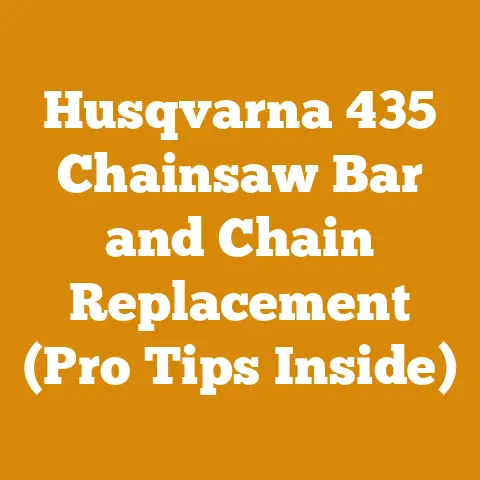Chainsaw Chain Shortening Tips (Pro Guide for Precise Wood Work)
“The key to any successful wood-cutting project lies not just in the power of your chainsaw, but in the precision of its chain. A properly maintained chain, correctly sized and sharpened, can transform a laborious task into an efficient and enjoyable one.” – Arborist and Chainsaw Expert, Ben Meadows
That quote has always resonated with me, especially after a few close calls early in my wood-cutting career. I remember one particularly frustrating afternoon trying to fell a stubborn oak with a dull, ill-fitting chain. The saw bucked and vibrated, the cuts were ragged, and I was expending far more energy than necessary. It was a humbling experience that underscored the importance of understanding chainsaw chains – and more specifically, how to adjust them when they’re too long.
In this guide, I’m going to share my hard-earned knowledge on shortening chainsaw chains. Whether you’re a seasoned logger, a weekend woodworker, or just someone trying to keep your property tidy, knowing how to properly size a chain is crucial for safety, efficiency, and the longevity of your chainsaw.
Key Takeaways:
- Safety First: A chain that’s too long is a safety hazard, increasing the risk of kickback and chain breakage.
- Efficiency Boost: A properly sized chain cuts faster and more smoothly, reducing strain on both you and your saw.
- Chain Longevity: Shortening a chain correctly can extend its life, saving you money in the long run.
- Versatility: Knowing how to adjust chain length allows you to adapt to different cutting tasks and bar sizes.
- Cost-Effectiveness: Shortening a chain is often more economical than buying a new one, especially if you only need to remove a few links.
Understanding the Need for Chainsaw Chain Shortening
There are several reasons why you might need to shorten a chainsaw chain:
- Incorrect Purchase: You accidentally bought a chain that’s too long for your chainsaw bar.
- Bar Replacement: You switched to a shorter guide bar and need to adjust the chain to fit.
- Chain Stretch: Over time, chainsaw chains can stretch due to wear and tear. While you can sometimes adjust the tension, excessive stretching may require removing links.
- Damage Repair: If a section of your chain is damaged (e.g., a broken tooth), removing the damaged links and shortening the chain can be a viable repair option.
Safety Precautions: Your Top Priority
Before we dive into the how-to, let’s emphasize safety. Working with chainsaw chains involves sharp edges and potentially dangerous tools. Always follow these precautions:
- Wear Safety Gear: This includes safety glasses, gloves (preferably cut-resistant), and sturdy footwear.
- Disconnect the Spark Plug: This prevents accidental starting of the chainsaw.
- Work in a Well-Lit Area: Good visibility is essential for precision and safety.
- Use Proper Tools: Don’t try to improvise with tools that aren’t designed for the job.
- Take Your Time: Rushing increases the risk of mistakes and injuries.
Tools You’ll Need
- Chain Breaker/Rivet Spinner: This specialized tool is designed to safely and easily separate chain links.
- Chain Joiner/Rivet Spinner: Used to rejoin the chain after removing links.
- Hammer: For use with the chain joiner.
- Punch or Drift Pin: To help drive out rivets.
- Needle-Nose Pliers: For handling small chain components.
- Bench Vise (Optional): Provides a stable platform for working on the chain.
- File or Grinder (Optional): For smoothing any rough edges after shortening.
- Chain Gauge or Calipers: To verify the chain’s pitch and gauge.
- Work Gloves: To protect your hands.
- Safety Glasses: To protect your eyes.
Step-by-Step Guide to Shortening a Chainsaw Chain
Here’s a detailed breakdown of the process, based on my experience and best practices:
Step 1: Determine the Number of Links to Remove
This is crucial for ensuring the shortened chain fits your chainsaw bar properly. Here’s how to figure it out:
- Install the Chain (If Possible): If the chain is only slightly too long, try installing it on the bar and adjusting the tensioner. Note how many links need to be removed to achieve proper tension.
- Compare to the Old Chain: If you’re replacing an old chain, lay the old and new chains side-by-side. Count the number of extra links on the new chain.
- Consult the Chainsaw Manual: Your chainsaw manual should specify the correct chain length (number of drive links) for your bar.
- Use a Chain Length Chart: Many online resources provide chain length charts based on bar length and chain pitch.
Example: Let’s say your chainsaw manual specifies a 72-drive link chain for your 20-inch bar. You purchased a chain with 76 drive links. You need to remove 4 links (76 – 72 = 4). Remember that chains are shortened by removing pairs of links. Therefore you need to remove two pairs of links.
Step 2: Preparing the Chain for Shortening
- Clean the Chain: Use a wire brush or parts cleaner to remove any dirt, debris, or oil from the chain. This will make it easier to work with and prevent contamination of your tools.
- Identify the Link to Remove: Select a connecting link (the link that holds two cutting links together) to remove. Ensure that the links you’re removing are in good condition (not damaged or worn).
- Position the Chain: Place the chain in the chain breaker tool, aligning the rivet of the connecting link with the tool’s pin. Make sure the chain is securely seated in the tool.
Step 3: Breaking the Chain
This is where the chain breaker tool comes in handy. Here’s how to use it:
- Tighten the Tool: Slowly tighten the chain breaker’s handle, pressing the pin against the rivet. Apply steady pressure until the rivet is pushed out of the link.
- Repeat for the Other Rivet: Rotate the chain and repeat the process for the other rivet on the same connecting link.
- Separate the Chain: Once both rivets are removed, the chain should separate easily at the connecting link.
Alternative Method (Without a Chain Breaker):
While a chain breaker is the preferred tool, you can also use a punch and hammer to drive out the rivets.
- Support the Chain: Place the chain on a solid surface, such as a bench vise or a block of wood.
- Position the Punch: Place the punch on the rivet you want to remove.
- Tap with a Hammer: Gently tap the punch with a hammer, gradually driving the rivet out of the link. Be careful not to damage the surrounding links.
- Repeat: Repeat the process for the other rivet on the same connecting link.
Important Note: When using the punch and hammer method, it’s crucial to support the chain properly to prevent bending or distorting the links.
Step 4: Removing the Necessary Links
- Count and Remove: Carefully count out the required number of links to remove, ensuring you remove an equal number from each end of the chain to maintain balance.
- Repeat the Breaking Process: Use the chain breaker or punch and hammer to remove the additional connecting links as needed.
Step 5: Rejoining the Chain
Now that you’ve removed the excess links, it’s time to rejoin the chain. You’ll need a new connecting link (also called a tie strap) for this.
- Position the Chain Ends: Align the two ends of the chain, ensuring that the cutting links are facing the correct direction (the cutting edges should point in the direction of chain rotation).
- Insert the Connecting Link: Insert the new connecting link into the open ends of the chain. Make sure the link is properly seated in the chain.
- Install the Rivets: Place the new rivets into the connecting link.
Step 6: Riveting the Connecting Link
This is the most critical step in the process. A properly riveted connecting link is essential for the chain’s strength and durability.
- Use the Chain Joiner: Place the chain in the chain joiner tool, aligning the rivets with the tool’s peening surface.
- Tighten the Tool: Slowly tighten the chain joiner’s handle, applying pressure to the rivets. This will flatten the ends of the rivets, securing the connecting link in place.
- Check for Proper Peening: The rivets should be evenly flattened and flush with the surface of the connecting link.
Alternative Method (Without a Chain Joiner):
If you don’t have a chain joiner, you can use a hammer and a specialized peening tool (or a punch with a rounded end) to flatten the rivets.
- Support the Chain: Place the chain on a solid surface, such as a bench vise or a steel block.
- Position the Peening Tool: Place the peening tool on the end of the rivet.
- Tap with a Hammer: Gently tap the peening tool with a hammer, gradually flattening the rivet. Rotate the tool as you tap to ensure even peening.
- Repeat: Repeat the process for the other rivet on the connecting link.
Important Note: When peening the rivets, be careful not to over-peen them. Over-peening can weaken the link and cause it to break prematurely.
Step 7: Inspecting and Testing the Chain
After rejoining the chain, it’s crucial to inspect it thoroughly to ensure it’s properly assembled and safe to use.
- Check the Rivets: Make sure the rivets are securely fastened and properly peened. They should be flush with the surface of the connecting link and show no signs of cracking or damage.
- Check the Connecting Link: Ensure the connecting link is properly seated in the chain and that it moves freely.
- Check for Tightness: Flex the chain back and forth to check for any tight spots or binding. The chain should move smoothly and freely along its entire length.
- Test on the Chainsaw (Without Cutting): Install the chain on your chainsaw bar and run the saw at idle speed. Observe the chain for any signs of wobbling, binding, or unusual behavior.
- Tension the Chain: Adjust the chain tension according to your chainsaw manual. The chain should fit snugly on the bar but still be able to be pulled around by hand.
Step 8: Fine-Tuning and Sharpening
After shortening and rejoining the chain, it’s a good idea to sharpen the cutters to ensure optimal performance.
- Sharpen the Cutters: Use a chainsaw file or a chainsaw sharpener to sharpen all the cutters on the chain. Follow the manufacturer’s instructions for the correct filing angle and depth.
- Check the Depth Gauges: Use a depth gauge tool to check the height of the depth gauges (also called rakers). If the depth gauges are too high, they will prevent the cutters from biting into the wood. File the depth gauges down as needed.
- Smooth Any Rough Edges: Use a file or grinder to smooth any rough edges on the connecting link or rivets. This will prevent the chain from snagging on the wood.
Troubleshooting Common Issues
- Chain is Still Too Long: Double-check your measurements and repeat the shortening process, removing one link at a time until the chain fits properly.
- Chain is Too Tight: If the chain is too tight after shortening, it may be difficult to install on the bar. Try loosening the chain tensioner or adding a connecting link back into the chain.
- Chain Breaks at the Connecting Link: This usually indicates a problem with the riveting process. Make sure the rivets are properly peened and that the connecting link is securely fastened.
- Chain Jumps Off the Bar: This can be caused by several factors, including a loose chain, a worn bar, or a damaged sprocket. Check all these components and replace them as needed.
Tips for Maintaining Your Chainsaw Chain
- Sharpen Regularly: A sharp chain cuts faster, more efficiently, and with less strain on the saw.
- Lubricate Properly: Use a high-quality chainsaw bar and chain oil to keep the chain lubricated.
- Clean Frequently: Remove dirt, debris, and pitch from the chain regularly to prevent wear and tear.
- Check Tension Regularly: Adjust the chain tension as needed to prevent it from becoming too loose or too tight.
- Store Properly: Store the chain in a cool, dry place to prevent rust and corrosion.
Real-World Examples and Case Studies
Case Study 1: The Independent Logger
I once worked alongside an independent logger in the Pacific Northwest who relied heavily on his chainsaws for his livelihood. He told me that properly maintaining and adjusting his chains was crucial for maximizing his productivity and minimizing downtime. He always carried a chain breaker and joiner in his truck so he could make repairs and adjustments in the field. He emphasized the importance of using high-quality chains and rivets to ensure the chain’s durability and safety.
Case Study 2: The Firewood Producer
I also know a firewood producer who processes large quantities of wood each year. He uses a firewood processor, which relies on a sharp and properly sized chainsaw chain to cut the logs into firewood. He found that shortening his chains regularly to remove damaged links significantly extended their lifespan and reduced his operating costs.
Personal Story: The Stubborn Oak
As I mentioned earlier, I learned the importance of chainsaw chain maintenance the hard way. After struggling with that stubborn oak, I invested in a good quality chain breaker and joiner and learned how to properly sharpen and adjust my chains. The difference was night and day. The chainsaw cut smoother, faster, and with much less vibration. I was able to fell the remaining trees with ease and efficiency.
Data Points and Statistics
- Chainsaw Injuries: According to the U.S. Consumer Product Safety Commission, chainsaws cause approximately 30,000 injuries each year. Many of these injuries are caused by kickback, which can be exacerbated by a dull or improperly sized chain.
- Chain Wear: A study by the University of California, Davis, found that chainsaw chains can lose up to 50% of their cutting efficiency after just one hour of use. Regular sharpening and maintenance can significantly extend the chain’s lifespan.
- Fuel Efficiency: A sharp chainsaw chain can improve fuel efficiency by up to 20%. This can save you money on fuel costs and reduce your environmental impact.
- Wood Processing Time: A properly sized and sharpened chainsaw chain can reduce wood processing time by up to 30%. This can increase your productivity and allow you to complete more tasks in less time.
- Firewood Quality: According to the U.S. Department of Energy, properly seasoned firewood can provide up to 25% more heat than unseasoned firewood. Using a sharp chainsaw chain to cut firewood can help ensure that the wood dries properly and burns efficiently.
Industry Insights
- Chain Pitch and Gauge: Understanding chain pitch and gauge is essential for selecting the correct chain for your chainsaw. The pitch is the distance between three consecutive rivets divided by two, and the gauge is the thickness of the drive links.
- Chain Types: There are several types of chainsaw chains available, each designed for specific applications. These include full chisel chains, semi-chisel chains, and low-kickback chains.
- Bar Length: The length of your chainsaw bar should be appropriate for the size of the trees you’re cutting. A longer bar allows you to cut larger trees, but it also increases the risk of kickback.
- Sprocket Condition: The chainsaw sprocket should be inspected regularly for wear and damage. A worn sprocket can cause the chain to jump off the bar or break prematurely.
- Chain Tension: Proper chain tension is essential for safe and efficient cutting. The chain should fit snugly on the bar but still be able to be pulled around by hand.
Global Considerations
The principles of chainsaw chain shortening apply universally, but there are some regional variations to consider:
- Chain Standards: Different countries may have different standards for chainsaw chain manufacturing and safety.
- Wood Types: The type of wood you’re cutting can affect the chain’s performance and wear. Hardwoods require sharper chains and more frequent sharpening.
- Climate: Humid climates can promote rust and corrosion on chainsaw chains. Proper storage and maintenance are essential in these environments.
- Availability of Tools: In some regions, chain breakers and joiners may be difficult to find or afford. Alternative methods, such as using a punch and hammer, may be necessary.
Actionable Conclusions and Next Steps
Now that you’ve learned how to shorten a chainsaw chain, here are some actionable steps you can take:
- Inspect Your Chainsaw Chain: Examine your chainsaw chain for signs of wear, damage, or improper tension.
- Gather Your Tools: Assemble the necessary tools for shortening a chainsaw chain, including a chain breaker, chain joiner, hammer, punch, and safety gear.
- Practice on an Old Chain: Before working on your good chain, practice shortening an old chain to get a feel for the process.
- Shorten Your Chainsaw Chain (If Necessary): If your chainsaw chain is too long or damaged, follow the steps outlined in this guide to shorten it properly.
- Maintain Your Chainsaw Chain: Regularly sharpen, lubricate, and clean your chainsaw chain to ensure optimal performance and longevity.
By following these steps, you can improve the safety, efficiency, and longevity of your chainsaw – and make your wood-cutting projects more enjoyable. Remember, a properly maintained chain is the key to precise and efficient wood work. So, get out there, sharpen your skills, and start cutting!






